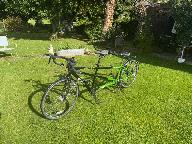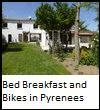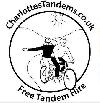Account
Discussions
Re: Vintage Claud Butler Tandem?
Hi Guys,
Just bought a C B Tandem, Chrome Frame[some surface rust otherwise very sound],Wheels 26 X 1-1/4[rusty rims] front Chater Lea Hub with knurled adjuster,Rear with Hub Brake and derrailier Gear Cyclo Birmingham, Cantilever Brakes,Rear Drum and Foot pedal,Eccentric Bottom Bracket,Numbers under B/Bracket 8/2/34,Bike is quite rideable as is, Any help would be welcome, Regards,William
: A threads not dead till the fat lady ties it off.
: Adam Kolaczkowski wrote
: This followed Iain Kent's enquiry on CB Ultra Shortbase 882842, with presumed
: patent No 1576/36.
: Claud patented the Ultra Shortbase design, curved seat-tube, in 1936. The
: patent number is given in his 1951 catalogue as 464,959. Perhaps Ian
: Butcher can do something with this.
: Iain's Claud 882842 is pre 1950. Serials are VERY handy when dating a frame,
: so if you really want to research a frameset, and any digits of the serial
: are unclear, you should remove the forks and read it from the fork steerer
: tube. Here all digits will be clear, as they are not painted over. The
: fork and frame numbers should be the same and so it may also confirm that
: the forks are the originals.
: The easiest Clauds to date are 1950 to Oct 1956 (when he went caput). John's
: is one of these: 502 789. Such numbers are stamped in 2 groups, a serial
: number and a date code. Sometimes the date code comes first, sometimes
: second, here it leads. It is always 3 or 4 digits, starting with a 5. Year
: then month. John's date group is 502, so made Feb 1950. Johns is so far
: the earliest one I have seen in this system, previously it was Avant
: Coureur 502 795. It is possible that this system had not started in Jan
: 1950, time will tell.
: This is very handy, because we know Claud's first bi-lams were 1948. So any
: bi-lams which do not have 1950's date embedded serials have to be 1948,
: 1949 or Jan 50. Indeed, the official launch of bi-lams was the Earls Court
: Cycle Show Oct/Nov 1948, so very few 1948 ones will exist. From this we
: find 1949 Claud serials all start with a 9, the number of digits varies.
: It appears from the other early Claud numbers I have gathered, some supported
: by invoices, that through the 30's and 40's the first digit is a year
: digit. I think this will prove to be correct, but I cannot say it with
: certainty yet.
: I think Iains 882842, which has to be 1936-49, will be 1938 or 1948. Adams
: 721468 will be 1947 (assuming he is right to rule out 1937).
: Clippie headsets were the norm pre-war. Bill Hurlow tells me the new headset
: design, with push-in cups were available on the Continent just pre war.
: The Brits called them Colonial headsets, the Aussies called them British
: headsets.
: Holdsworth used clippies exclusively Pre war, except on the 1939 Anglo
: Continental, and continued using clippies though 1946, but by 1947
: Holdsworth used the newer 'Colonial' headsets only. I was therefore
: surprised that Glasgow Museum of Transport has a BILAM CB Ultra Shortbase
: tandem (so 1948+) with a clippie headset. This is not yet on display to
: the public so I don't have the serial (yet). So while Iains clippie tells
: us it's an old tandem, pre 1950, it does not tell us whether pre or post
: war. It could still be 1948, even with a clippie. (However, if it's a
: bi-lam it would have to be 1948).
: I hope this helps a little,
: Good luck, Norman (Glasgow)
 nly just allowed me to play the "internet short claud game", very interesting....
nly just allowed me to play the "internet short claud game", very interesting....
Not up to speed on the numbering of these lovely bits of metal, but from what I have picked up,the early prewar ones differed in a few subtle ways to the frames of the mid fifties. The very old ones were very up close and intimate at the rear. The rear top tube (for a 21" size) was under 20", where as the last ones seem to be around 22". For the early machines, where the seat stays attach to the rear seat cluster was quite ugly: it has a stepped infill about 15mm long the last bit of which is reduced to half the diameter of the tube. The last ones had a very much prettier feature perhaps 80 mm long: usually a angled flat plate, sometimes a u-section where the angled cut portion has been brazed back in upside down, so to speak. The machines of late 40's / early fifties had a shorter angled plate, perhaps 30mm long. The frame angles crept up over the years: perhaps 68 degree head to start, 71/72 at end. The easy one to spot, though is that the late Clauds were all lugless. I remember speaking to some one around at the time, and he explained that the lugs just stopped being made. The headset game is interesting from that time, cos I've got machines with the standard clamp, yet push in cups, as well as a very late machine with a screw headset on push in cups. Ironically, the clamp headsets, which I am no fan of, can convert very much more easily to modern mountain bike running gear, than the screw headsets (the only advance from mountain bikes, for me). And just to follow on from my letter to the TCJ the other month, these lovely machines, like Shire Horses, and a dying breed and are ever less valued. I bought (another) frame at the last cycle jumble I went to for an embarising small amount. Well sad.
Hi Guys,
: Just bought a C B Tandem, Chrome Frame[some surface rust otherwise very
: sound],Wheels 26 X 1-1/4[rusty rims] front Chater Lea Hub with knurled
: adjuster,Rear with Hub Brake and derrailier Gear Cyclo Birmingham,
: Cantilever Brakes,Rear Drum and Foot pedal,Eccentric Bottom
: Bracket,Numbers under B/Bracket 8/2/34,Bike is quite rideable as is, Any
: help would be welcome, Regards,William
: Hi Guys,
: Just bought a C B Tandem, Chrome Frame[some surface rust otherwise very
: sound],Wheels 26 X 1-1/4[rusty rims] front Chater Lea Hub with knurled
: adjuster,Rear with Hub Brake and derrailier Gear Cyclo Birmingham,
: Cantilever Brakes,Rear Drum and Foot pedal,Eccentric Bottom
: Bracket,Numbers under B/Bracket 8/2/34,Bike is quite rideable as is, Any
: help would be welcome, Regards,William
Re the tandem in the Glasgow Transport Museum. This was my father's tandem which we donated to the museum after he died. If you managed to get any further info into the year it was built I would love to hear from you.
: Had an old CB super ace tandem years ago. Back end of last year met the guy I sold it to and he asked if I wanted it back, so it's back home. I have been giving it some TLC over the winter and found this thread while looking for something else. Anyway it has a serial no. 45720 can anyone help date this
: Hi Guys,
: Just bought a C B Tandem, Chrome Frame[some surface rust otherwise very
: sound],Wheels 26 X 1-1/4[rusty rims] front Chater Lea Hub with knurled
: adjuster,Rear with Hub Brake and derrailier Gear Cyclo Birmingham,
: Cantilever Brakes,Rear Drum and Foot pedal,Eccentric Bottom
: Bracket,Numbers under B/Bracket 8/2/34,Bike is quite rideable as is, Any
: help would be welcome, Regards,William
Hi Guys, just bought a SWB Claud Butler Tandem serial no 396 551 W
Has 26 x 1 1/4 rims which are rusty. I'd like to save the old rear hub drum brake and get some new alloy 700c rims. Any thoughts?
Kind Regards
Gary
: Hi Guys, just bought a SWB Claud Butler Tandem serial no 396 551 W
: Has 26 x 1 1/4 rims which are rusty. I'd like to save the old rear hub drum
: brake and get some new alloy 700c rims. Any thoughts?
: Kind Regards
: Gary
We have had our CB USWB frame since 1956 when we bought it from new and added parts that we could afford. Several years ago we decided to bring it more up to date changing the 26 inch wheels for 700c. - 26 inch were becoming less popular. We new more space would be needed between tyre and frame so we went to a local frame builder saying we wanted to use 35 mm tyres as well as mudguards. He changed the rear drop outs for vertical drop outs and lightly straightened the front forks which proved to be a mistake as it made the tandem very twitchy. After a while we got him to re-set the forks and accepted that 28 mm tyres were the maximum we could use. I have since wondered if we should have gone for mountain bike wheels, they weren't so freely available at the time nor I suspect were the narrow tyre sizes, certainly the conventional view of a mountain bike tyre meant it wouldn't have fitted between the chainstays.
You may have to search for hubs to fit the old frame as modern ones are wider, as to rims, although many people say you should have 48 hole rims we have had virtually no trouble with 36 hole rims, just make sure you find a good wheel builder. Another thing that may help in this direction is that we have the cranks set at 90 degrees out of phase, this reduces the maximum torque applied to the spokes without reducing the overall effort available. It creates a smoother ride and now we never stall when setting off and it doesn't really matter where the pedals are when you do start off - a useful feature if you are in a hurry to get away.
Originally we had fitted a British Hub Company rear hub brake after we had blown a rear tyre while descending a hill. The hub brake never worked well and was very heavy so that was one of the first things to go. Discussing braking with other tandem riders several said they had had no problem with just ordinary cantilever brakes but, again descending a very steep hill, I was concerned that should one brake cable fail we would be in a rather embarrassing situation. We fitted a simple calliper to the rear wheel operated from a junior lever on the stokers handlebars and this has proved to be a great success, however I must admit to occasionally getting off the tandem on a steep hill to let the rims cool down. It is certainly cheaper than fitting a disc and hoping it won't melt.
Good luck with the renovation.
: We have had our CB USWB frame since 1956 when we bought it from new and added
: parts that we could afford. Several years ago we decided to bring it more
: up to date changing the 26 inch wheels for 700c. - 26 inch were becoming
: less popular. We new more space would be needed between tyre and frame so
: we went to a local frame builder saying we wanted to use 35 mm tyres as
: well as mudguards. He changed the rear drop outs for vertical drop outs
: and lightly straightened the front forks which proved to be a mistake as
: it made the tandem very twitchy. After a while we got him to re-set the
: forks and accepted that 28 mm tyres were the maximum we could use. I have
: since wondered if we should have gone for mountain bike wheels, they
: weren't so freely available at the time nor I suspect were the narrow tyre
: sizes, certainly the conventional view of a mountain bike tyre meant it
: wouldn't have fitted between the chainstays.
: You may have to search for hubs to fit the old frame as modern ones are
: wider, as to rims, although many people say you should have 48 hole rims
: we have had virtually no trouble with 36 hole rims, just make sure you
: find a good wheel builder. Another thing that may help in this direction
: is that we have the cranks set at 90 degrees out of phase, this reduces
: the maximum torque applied to the spokes without reducing the overall
: effort available. It creates a smoother ride and now we never stall when
: setting off and it doesn't really matter where the pedals are when you do
: start off - a useful feature if you are in a hurry to get away.
: Originally we had fitted a British Hub Company rear hub brake after we had
: blown a rear tyre while descending a hill. The hub brake never worked well
: and was very heavy so that was one of the first things to go. Discussing
: braking with other tandem riders several said they had had no problem with
: just ordinary cantilever brakes but, again descending a very steep hill, I
: was concerned that should one brake cable fail we would be in a rather
: embarrassing situation. We fitted a simple calliper to the rear wheel
: operated from a junior lever on the stokers handlebars and this has proved
: to be a great success, however I must admit to occasionally getting off
: the tandem on a steep hill to let the rims cool down. It is certainly
: cheaper than fitting a disc and hoping it won't melt.
: Good luck with the renovation.
Hi, thank you for your reply which was most interesting. I tried a 700c wheel off my other road bike and it fitted ok. This had a 700 x 23 tyre fitted, as these inflate to 125 psi I see no problem with the tyres carrying the extra load. May be a bit bumpy, but should go like the wind! I also tried a mountain bike wheel, although marked 26" they are way smaller than 26 x 11/4. The brakes will not reach the rim, far too small. I just found some new old stock Mavic 40 hole tandem rims, they are 700c. I'm going to get a guy to build them using the old rear brake hub ( which works ok ) and a new wide flange front hub. The rear hub brake is operated by a foot pedal connected to a rod. I ofen wondered about setting the cranks out of sync, makes sence to have them slightly off.
I would love to see some pictures of your Claud, as I'm sure many others would.
Does anyone know the age of my bike from the serial number??
Kind Regards
:
: I would love to see some pictures of your Claud, as I'm sure many others
: would.
Re the above This is the first time I have tried to add a picture, I hope it works. It was taken when we were somewhat younger. You can just see the huge British Hub Company drum brake that I operated from one lever, and at the time we had a Mafak lever that would operate on the two cantilever brakes. We eventually realised this was not a good idea as not only did it rely on both brakes being set up properly, but of course you only had the strength of one hand distributed over the two brakes. The foot brake is a better idea.
You will also note we drove from the front chainset, We set it up this way as we wanted to have a double chainset and 5 speed block and thought the additional chain misalignment would be too great. It seems strange now that we have 11 speed blocks, however although it was possible at the time, nowadays I doubt if you can find a front changer that will sit correctly on the almost vertical portion of the rear curved seat tube.
Re 90 degree Out of Phase pedals we also found that as there are two ways of being out of phase, either the pilot or the stoker leading the rotation, you may find that one way tends to create a wobble. So try both before you give up. We think it is ideal for touring, probably not good for racing, and certainly makes honking difficult, but then possibly because of the smoother transmission we rarely find it a benefit.
When the opportunity arises I shall try to upload a picture of it as it is today.
Roy

I've had experience of fitting 700c wheels to old tandems, and it’s always, for me, worked out well. Most USB Clauds were made for 26" wheels, which are approx 1/2" smaller at the rim than 700C. We run 700 x 28mm Schwalbe Marathons, a little bit thinner than the original 26 x 1 1/4" which corresponds to 32mm. A 12mm bigger rim (on radius) with a 4mm smaller tyre will raise the bottom brackets up slightly, which can be offset a bit by running the rear wheel at the furthest back position on the fork end. It makes little difference in practice.
Normally the spacing of the rear fork ends is too narrow for easy fitting of modern hubs. Damn nuisance. Unlike a solo bike where I can easily spring the rear forks out maybe 10mm each side, tandem rear ends, and especially USB machines, are much less cooperative in this regard. Depending on what gearing is wanted to be used, often one has to resort to resetting the spacing. Frame builders often do this hot: I have cold set rear ends without problem. If you are lucky, you'll have a late Claud, which have 126mm spacing at the back which is wide enough for me to use modern gears, though I admit to not using the latest 11 speed rear cassettes. These late CBs were sometimes built for 27 x 1 1/4" wheels: these are 4 mm bigger on radius, so a bit of thought has to be given to not scraping pedals whilst cornering. I've done this by putting the rear wheel most forward in the rear dropouts, and positioning the front eccentric so that the spindle is in the top half.
I've never found the old-school tandem hub brakes any good. Whilst sturdy and well made, they do indeed weigh a lot, and they just don't work very well at all. We run modern V brakes for normal use. As I still use down tube shifters and drop bars, I can use the long cable pull Tektro brake levers, and this works well. The pivots for the brake arms did need brazing on, but for us this was a good idea. I have a drag brake for when I know we're going to have long down hills, as we have blown off a rear tyre from overheating, which I found somewhat challenging.
Another machine I had was slowed by good old fashioned bolt on Weinmann centre pull callipers. It worked extraordinarily well, so if the mood is not upon you to resort to having bits brazed on this may do it.
: I've had experience of fitting 700c wheels to old tandems, and it’s always,
: for me, worked out well. Most USB Clauds were made for 26" wheels,
: which are approx 1/2" smaller at the rim than 700C. We run 700 x 28mm
: Schwalbe Marathons, a little bit thinner than the original 26 x 1
: 1/4" which corresponds to 32mm. A 12mm bigger rim (on radius) with a
: 4mm smaller tyre will raise the bottom brackets up slightly, which can be
: offset a bit by running the rear wheel at the furthest back position on
: the fork end. It makes little difference in practice.
: Normally the spacing of the rear fork ends is too narrow for easy fitting of
: modern hubs. Damn nuisance. Unlike a solo bike where I can easily spring
: the rear forks out maybe 10mm each side, tandem rear ends, and especially
: USB machines, are much less cooperative in this regard. Depending on what
: gearing is wanted to be used, often one has to resort to resetting the
: spacing. Frame builders often do this hot: I have cold set rear ends
: without problem. If you are lucky, you'll have a late Claud, which have
: 126mm spacing at the back which is wide enough for me to use modern gears,
: though I admit to not using the latest 11 speed rear cassettes. These late
: CBs were sometimes built for 27 x 1 1/4" wheels: these are 4 mm
: bigger on radius, so a bit of thought has to be given to not scraping
: pedals whilst cornering. I've done this by putting the rear wheel most
: forward in the rear dropouts, and positioning the front eccentric so that
: the spindle is in the top half.
: I've never found the old-school tandem hub brakes any good. Whilst sturdy and
: well made, they do indeed weigh a lot, and they just don't work very well
: at all. We run modern V brakes for normal use. As I still use down tube
: shifters and drop bars, I can use the long cable pull Tektro brake levers,
: and this works well. The pivots for the brake arms did need brazing on,
: but for us this was a good idea. I have a drag brake for when I know we're
: going to have long down hills, as we have blown off a rear tyre from
: overheating, which I found somewhat challenging.
: Another machine I had was slowed by good old fashioned bolt on Weinmann
: centre pull callipers. It worked extraordinarily well, so if the mood is
: not upon you to resort to having bits brazed on this may do it.
Well, my second SWB Claud has just arrived. Just couldnt help myself!!
What a mess it is too, hand painted and looks like the headset has been braised back on or repaired. My Chain rings are worn on the first Claud and the saddles are too modern. This hand painted one has a couple of nice Brooks saddles and the chain rings look ok, I'm also told they're original.
I'm going to pinch the parts off it for the other one, then rebuild the second Claud from scratch while I ride the other. The first one is black with original decals, can't bring myself to paint it.
Funny, I have some Weinmann centerpull brakes in the shed. That was a good tip :0)
Gary
1/ The clamp headset that is nearly but not quite universal on all the old Clauds (some of the very last had screwded ones) can provide hours of amusement trying to upgrade. A game I've recently carried out involves removing the race from the uppermost part of the stack, the meaty clamp bit (which in itself is a bit of a trick), then using a modern A-head shim and stem instead. The result is much lighter and I would guess stronger than the original.
2/ Finishes and paintwork can make restoring old tandems a financial no-no from the start. A lovely couple I was speaking to a couple of weeks ago said that having their Argos tandem resprayed cost them more than the whole machine had cost them a decade before. And that's a modern Argos, which would fetch one hellofalot more than a USB CB.
3/ The standard old tandem chainset is William C34. These are 3 arm cranks, usually with a 42 tooth front to back, and the rear around 48T. On the rear the 42T has a wide spacer attached to the ring that bolts in 6 positions to the 48T. Weighs lots but usually lasts forever. For more outlay, it could of been spec'd with Chater Lea 3 arm cranks. These are longer arms, so the rings aren't compatible with Williams. CB also had cranks with their own name on them. I've seen them in both sizes.
4/ The excellent Nick Tithcott does all the CB transfers, but I agree it would be a shame to repaint anything that has original graphics.
4/ Beware the collecting of old tandems. If you are so minded, it's easy to acquire, quite literally, a shed-full. Despite their reduced wheelbase, the USB Clauds still take up a fair bit of room, and so unless you watch out, suddenly there is no space left. Beware!
: Gary
: 1/ The clamp headset that is nearly but not quite universal on all the old
: Clauds (some of the very last had screwded ones) can provide hours of
: amusement trying to upgrade. A game I've recently carried out involves
: removing the race from the uppermost part of the stack, the meaty clamp
: bit (which in itself is a bit of a trick), then using a modern A-head shim
: and stem instead. The result is much lighter and I would guess stronger
: than the original.
: 2/ Finishes and paintwork can make restoring old tandems a financial no-no
: from the start. A lovely couple I was speaking to a couple of weeks ago
: said that having their Argos tandem resprayed cost them more than the
: whole machine had cost them a decade before. And that's a modern Argos,
: which would fetch one hellofalot more than a USB CB.
: 3/ The standard old tandem chainset is William C34. These are 3 arm cranks,
: usually with a 42 tooth front to back, and the rear around 48T. On the
: rear the 42T has a wide spacer attached to the ring that bolts in 6
: positions to the 48T. Weighs lots but usually lasts forever. For more
: outlay, it could of been spec'd with Chater Lea 3 arm cranks. These are
: longer arms, so the rings aren't compatible with Williams. CB also had
: cranks with their own name on them. I've seen them in both sizes.
: 4/ The excellent Nick Tithcott does all the CB transfers, but I agree it
: would be a shame to repaint anything that has original graphics.
: 4/ Beware the collecting of old tandems. If you are so minded, it's easy to
: acquire, quite literally, a shed-full. Despite their reduced wheelbase,
: the USB Clauds still take up a fair bit of room, and so unless you watch
: out, suddenly there is no space left. Beware!
The black original Claud has no clamp on the headset, must get the pictures of it off my phone and post them. The chain rings have CT in them, must be Chater Lea I guess. They are worn which is a shame so I'll have to borrow the William ones off the horrible hand painted Claud. The hand painted Claud has no foot brake, or any sign of where one has ever been. It has no bracket brazed on for the hub brake at the rear either, just a clamp on bracket that can be removed.
Will load up some pictures soon.
Thanks for the info folks.
: The black original Claud has no clamp on the headset, must get the pictures
: of it off my phone and post them. The chain rings have CT in them, must be
: Chater Lea I guess. They are worn which is a shame so I'll have to borrow
: the William ones off the horrible hand painted Claud. The hand painted
: Claud has no foot brake, or any sign of where one has ever been. It has no
: bracket brazed on for the hub brake at the rear either, just a clamp on
: bracket that can be removed.
: Will load up some pictures soon.
: Thanks for the info folks.
Ps
The hand painted Claud is item number 230837276594 on Ebay which is where I bought it.
Hello, I am currently trying to date a ladies Claud Butler and found your post about dating CB Tandems and frame numbers. Very useful and has helped me to date my bike to either 1934, 1940 or 1944 as the frame number is 405706. I believe that it is a ladies lightweight, unfortunatley it was "reconditioned" some time ago and lost many of its original features like the gearing set up, original paint and decals.
I have looked at CB catalogues online from this time and this has certainly helped with many of the details but no firm date on the bike.
Any thoughts on dating the bike from the frame number would be much appreciated.






